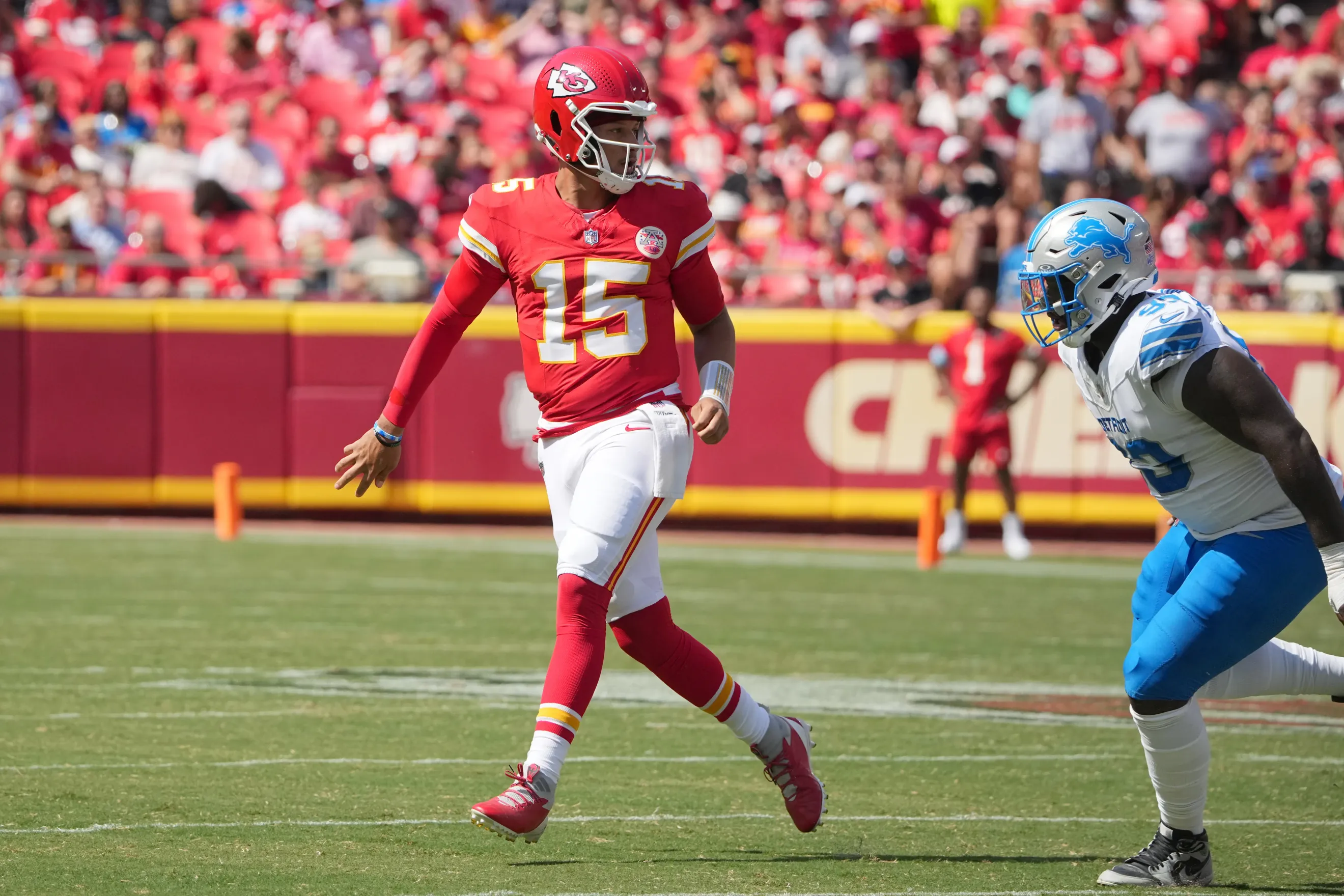
Quick Slant: SNF - A Touch of Winter for Your Fall
Mat Irby’s Quick Slant
The Andy Reid/Patrick Mahomes Chiefs used to bring about such excitement in their infancy together that it seemed to ride on old momentum for two more. It took a while for our emotions to catch up, but finally, we logged it in such a way that it stuck: Chiefs, not exciting; Chiefs, boring.
And just as the I’s and O’s from the old programming were finally replaced with new I’s and O’s, it now kinda, sorta, seems like maybe we rushed into that deduction?? QB Patrick Mahomes grasps at resurgence, WR Xavier Worthy is seemingly healthy(ish), and WR Rashee Rice stands eagerly in the on-deck circle, the power-hitter everyone here came to see. So, it may be time to face new facts: Chiefs, not boring; Chiefs, exciting.
Elsewhere, in the Midwest, there is no confusion about Detroit. They run possibly the best offense in the game. The Lions have become so fun—such a new wind in the NFL—that they’ve become a meme for bandwagonning. Everywhere you turn, there are Lions hats, sweatshirts, jerseys, and bumper stickers filling a space where there seemingly were none.
These aren’t your dad’s Lions; there is no Marty Mornhinweg on the sideline, no Drew Stanton taking snaps. They are DGAF, pedal-to-the-metal, no mercies given, no-punts-allowed pure high-octane accelerant. Their HC, Dan Campbell, has become an icon of the new analytics-based NFL—a coach for the intelligentsia—a bit of bourgeoisie for your meat and three and black coffee. Lions, not boring; Lions, exciting.
Together, Reid and Campbell may be the two most popular coaches in the league. Their brands are electrifying, creative, and highly competitive. Their QBs are lionhearts, their defenses physical. And when the calendar turns to January, they will be on time for their reservation—final four fixtures, possible Super Bowl foes.
But we don’t have to wait until then; this battle of mythic titans falls to us now, disguised as an interdivisional regular-season game in Week 6—a touch of winter for your fall.
Lions
Implied Team Total: 25
The Lions and Chiefs meet at GEHA Field at Arrowhead Stadium for Sunday night’s game, which is expected to be a shootout with the highest over/under of the week at 52.5.
The Lions rank third in Pythagorean expected wins, a model based on points-for vs. points-against. They are on pace for 14 wins a year after earning 15.
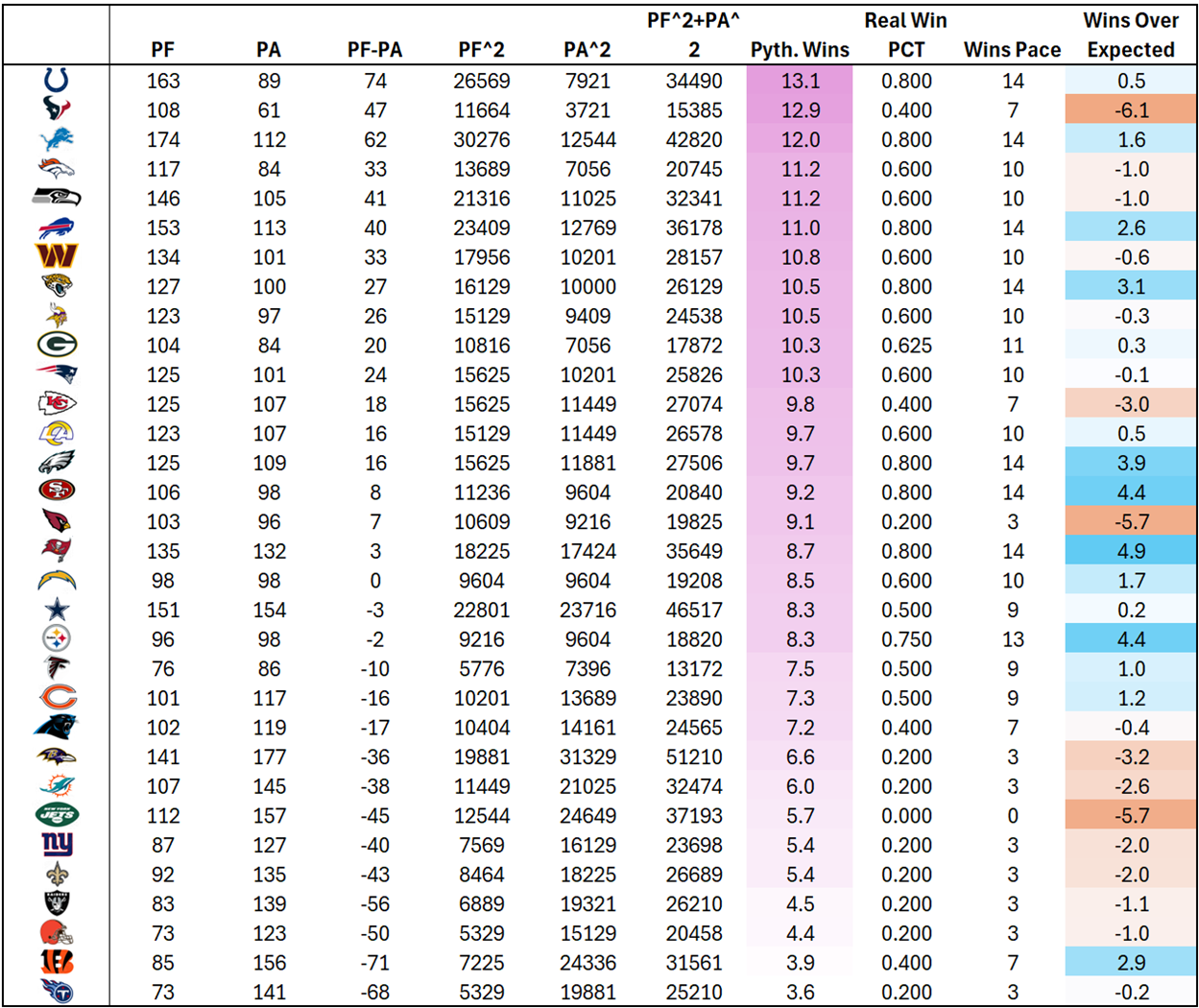
The Lions have one of the best, if not the best, offenses in the league. They have the highest points per game average (34.8). They rank fifth in offensive EPA per play and third in offensive success rate.
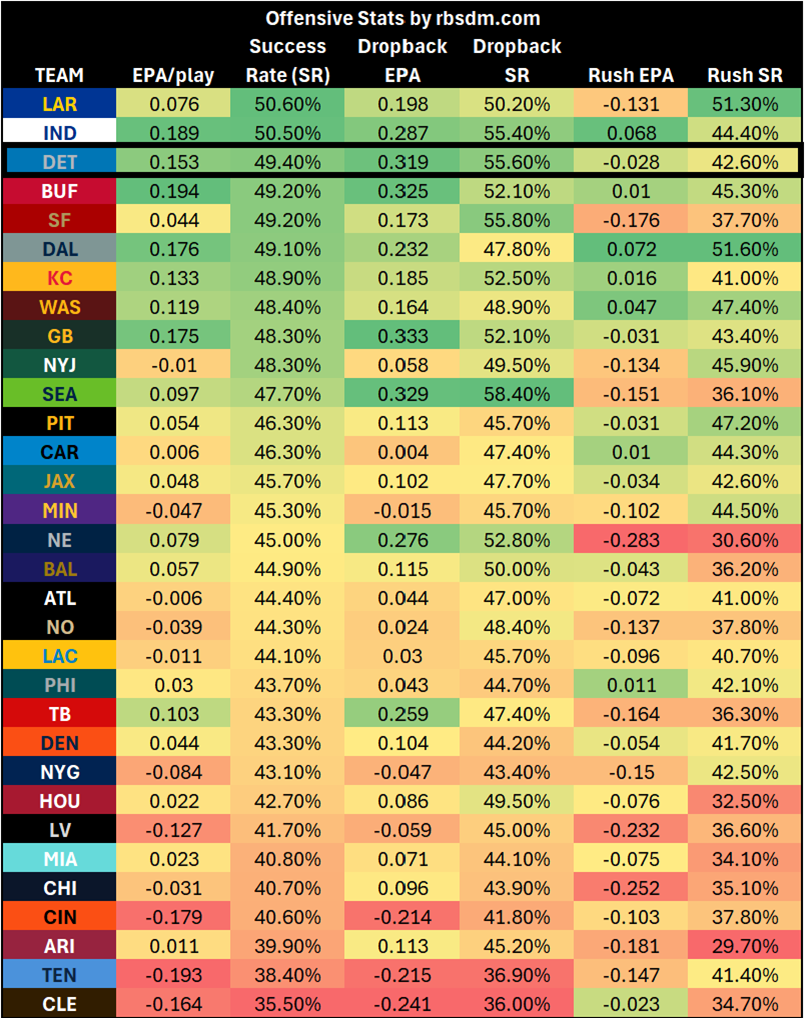
The Lions are the slowest team in the league at the line, at 29.6 seconds per snap. They are also the rush-heaviest team, with a 49% run rate, and have the third-lowest pass rate over expected rate (PROE) at -8.1%. They have run 316 total offensive plays, which is middle of the pack. But they sustain drives, finish with TDs, and stay efficient.
They are also prone to pressing the gas, even when they have a lead. They have spent almost as many plays from a lead of seven or more (149, 1st) as they have from a neutral script (150, 27th). With a lead of seven or more, they have actually been slightly faster at the line (28.4 seconds to snap, 21st) than they have from a neutral script. Their run rate also decreases to 46%. This is unusual.
The Lions’ QB is Jared Goff. Goff is generally a better real-life QB than a fantasy one, primarily because he lacks a rushing element entirely. He may also be publicly perceived as a second-rate QB because the Rams, despite all their winning, traded him and a bevy of assets for Matthew Stafford (and then won it all), right at the front edge of Goff’s prime.
Maybe there’s something to the fact that Goff has spent his entire career on teams with intelligent play callers and smart front office people; perhaps his winning percentage and passing efficiency metrics have been inflated by this. But without knowing where that starts and stops, we must give Goff some credit for how well his teams have performed throughout most of his professional life.
In 2025, Goff has dropped back only 156 times (20th). He has the best completion percentage (75.2%) and most passing TDs (12) in the league. Goff has a 120.7 QB rating (2nd). He ranks 3rd in EPA + CPOE Composite, trailing only Sam Darnold and Jordan Love.
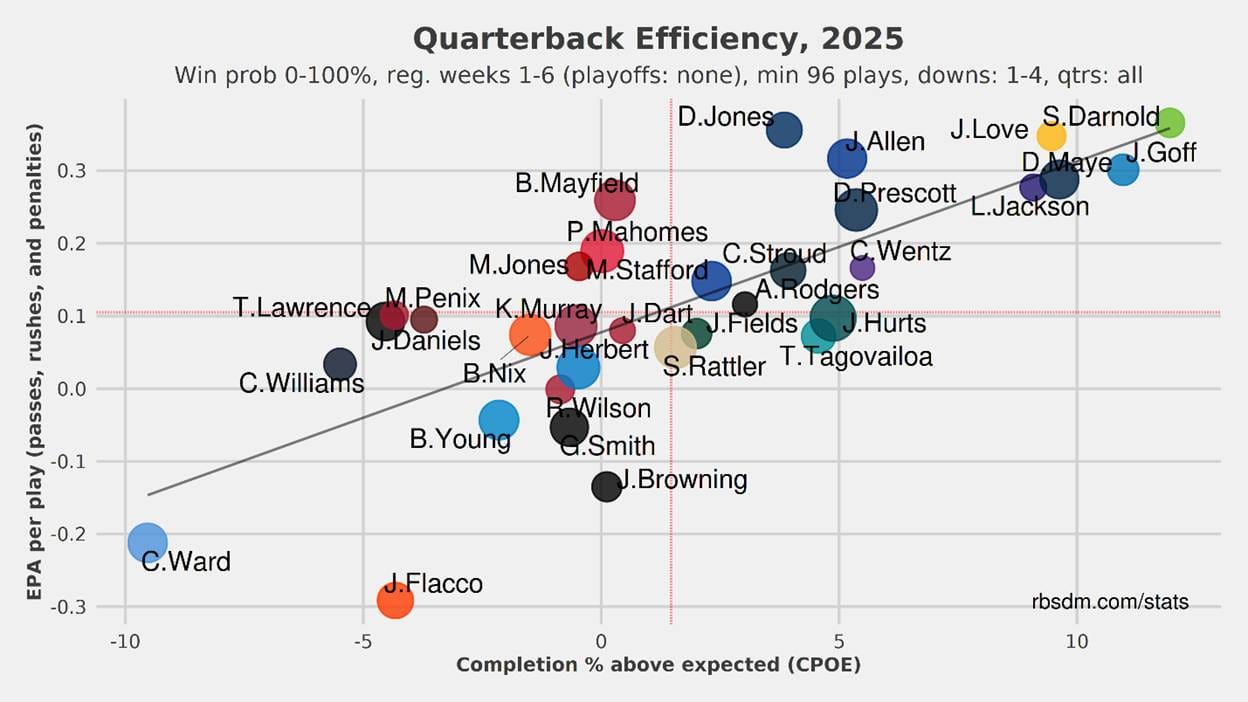
So, what we are left with is an offense that doesn’t throw often, but when it does, it maintains consistent and effective production. This makes Goff more vulnerable to TD volatility, which will dramatically swing his efficiency metrics per game. Goff is one of the most significant negative TD regression candidates among QBs based on a simple TDs/Yds regression model, where he has almost four TDs over expected.
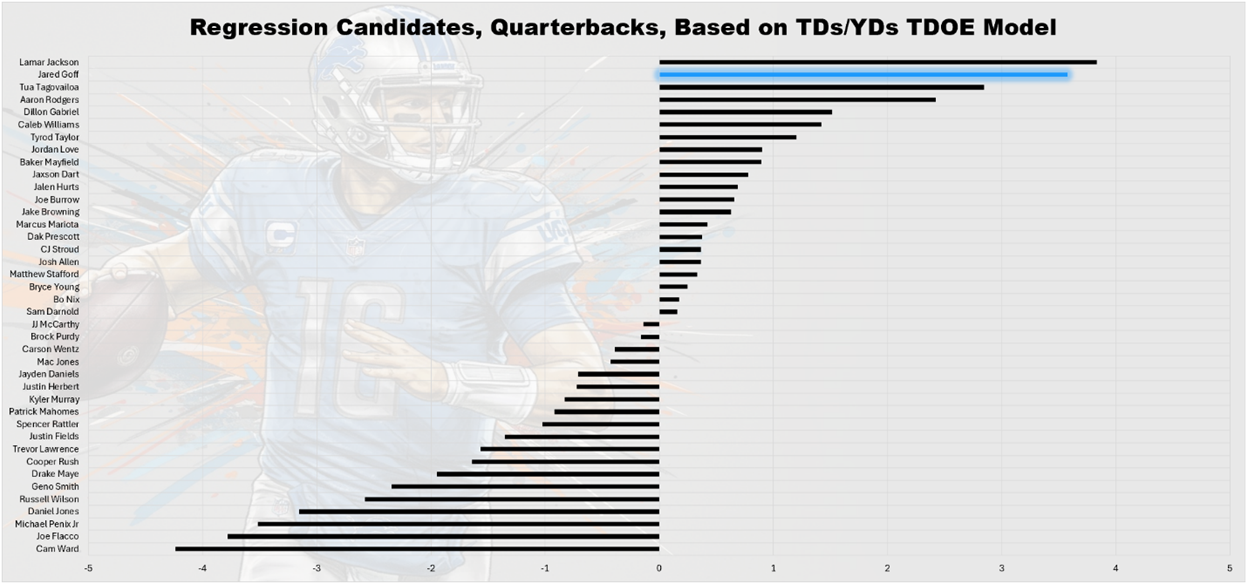
Goff is almost always playable, but with the caveat that he has low lows. With no rushing production to insulate him, he must score TDs on such truncated volume to make a meaningful impact. Better to chase this archetype on one of the best offenses in the league than otherwise, but Goff is bound to bounce back and forth between frustrating and vitalizing.
The Lions have four pass-catchers with more than a 15% target share: Amon-Ra St. Brown (29%), TE Sam LaPorta (19%), RB Jahmyr Gibbs (17%), and WR Jameson Williams (15%).
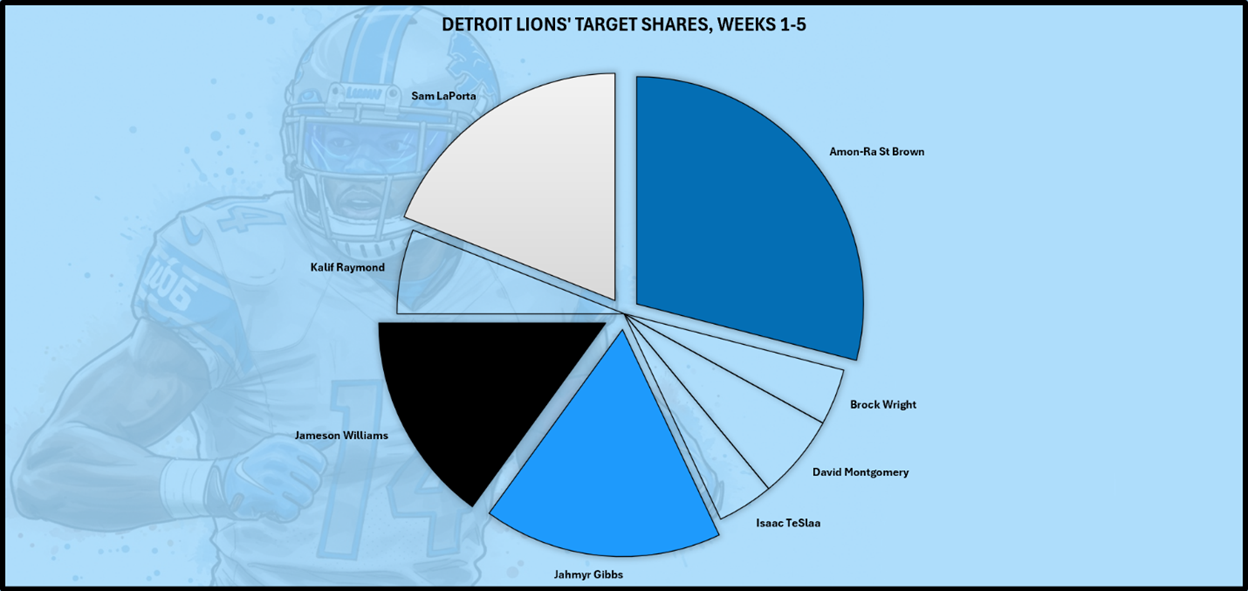
In a low-volume offense like this, Williams verges on being hard to use with a 15% target share. To pay off, he must be highly efficient; thus far, he is not, with a total EPA of 20.43 (34th) and a yards per route run (YPRR) of 1.48 (74th).
Williams’ aDOT, however, is higher than ever at 19.9 (3rd), trailing only Chiefs’ WR Tyquan Thornton and Colts' WR Adonai Mitchell. This puts Williams in an archetype that many may not want to admit: a field-stretcher.
Field stretchers are somewhat high-risk, high-reward in that they are prone to low volume, which usually results in low reception and yardage totals, but they are also prone to long TDs, which can sometimes come in clusters. This means they are generally avoidable, but can be seen as a pathway to realistic upside in any one-game sample.
The star of the Lions’ passing attack is, of course, St. Brown. He has 35 receptions (3rd), six TDs (1st), 2.71 YPRR (5th), 25 first downs (2nd), 28% targets per route run (TPRR, 10th), 35 first-read targets (T-8th), and 80.6 expected fantasy points (XFP, 6th). He has 22.5 fantasy points per game (FP/G, 2nd).
The Chiefs run a fairly parallel mix of man and zone relative to NFL norms, running zone about twice as often as man, but they run a far greater amount of 2-high safety (62.4%, 3rd).
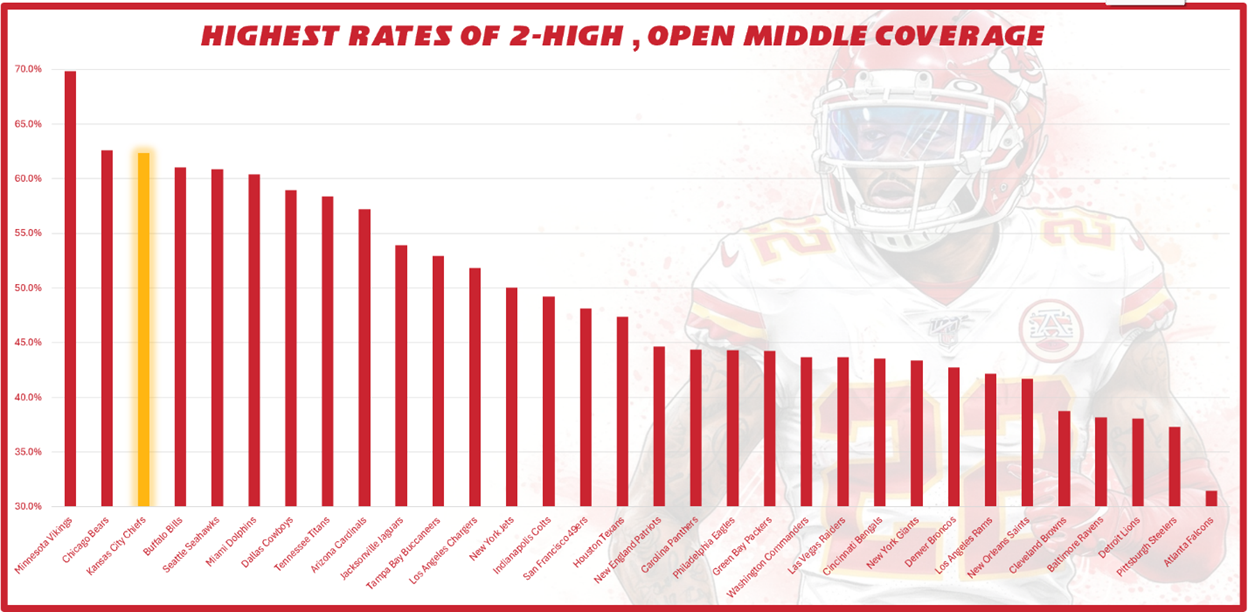
Uniquely, they don’t use any alignment more than 25%, though their most common alignments are Cover 3 (23.0%, 28th) and Cover 2 (22.5%, 6th). This means they run a wider array of defensive alignments. They are also blitz-heavy (32.0%, 6th) and run the highest rate of Cover 0 by far (10.7%).
The Chiefs have an excellent reputation for being an elite defense, but they really haven’t been this season. They rank 23rd in defensive EPA per play and 23rd in defensive success rate this season.
The immediate takeaway is that Williams would suffer due to the abundance of shell coverage, as two-high safety looks tend to hold deep-area specialists at bay. But, while Williams has been targeted deep eight times (+20 yards), he has had more success in the middle intermediate range, which is where a 2-high safety look is most vulnerable. He has not been overly successful down the sidelines at depth anyway. And, of course, Cover 0 blitzes are vulnerable to big plays, as the force man-to-man coverage on the outside with no over-the-top help.
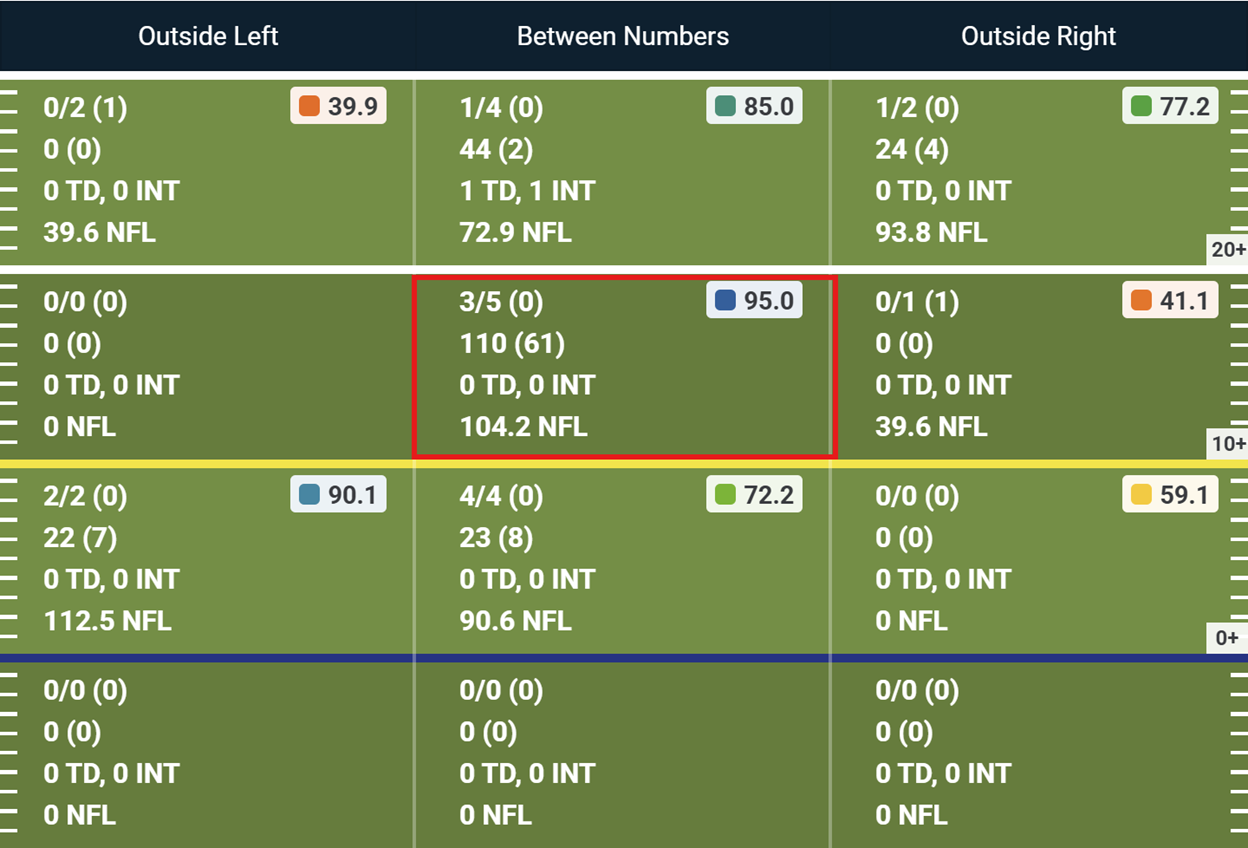
Williams actually has the Lions’ best matchup of the week based on Fantasy Points’ coverage matchup tool (+17.2%), which is based on the types and rates of coverage the Chiefs utilize. St. Brown’s matchup is barely above neutral, while LaPorta’s is barely below.
PFF’s matchup tool is personnel-based. According to it, St. Brown should enjoy a good matchup, WR Isaac TeSlaa should receive a fair matchup, Williams should receive a poor matchup, and TE Sam LaPorta should receive a good matchup. WR Kalif Raymond is listed as questionable and may not play.
The Lions’ offensive line has been quite good in the run game, earning 2.32 adjusted yards before contact/attempt (Adj. YBC/Att, 6th), and quite mediocre in the pass game, allowing a 1.4% pressure rate over expected (PrROE, 25th). In this one, their advantages and disadvantages will lie on these same lines.
In pass-blocking, the Lions should have a slight disadvantage. The Chiefs have the best defensive PrROE generation in the league, creating the most considerable disparity between any two teams in these areas.
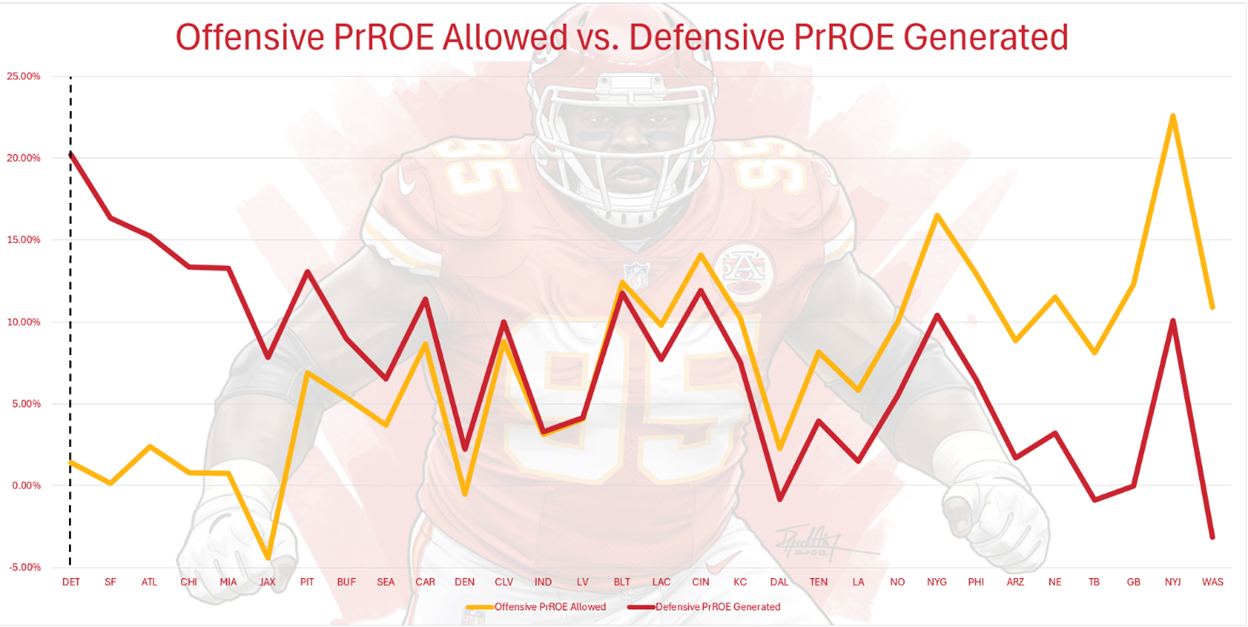
The composite of what the Lions’ offensive adj. YBC/Att and the Chiefs’ defensive adj. YBC/Att gives the Lions the fourth-biggest run-blocking advantage of the week. LT Taylor Decker will miss his second straight game with an injury; veteran swing T Dan Skipper will start in his place.
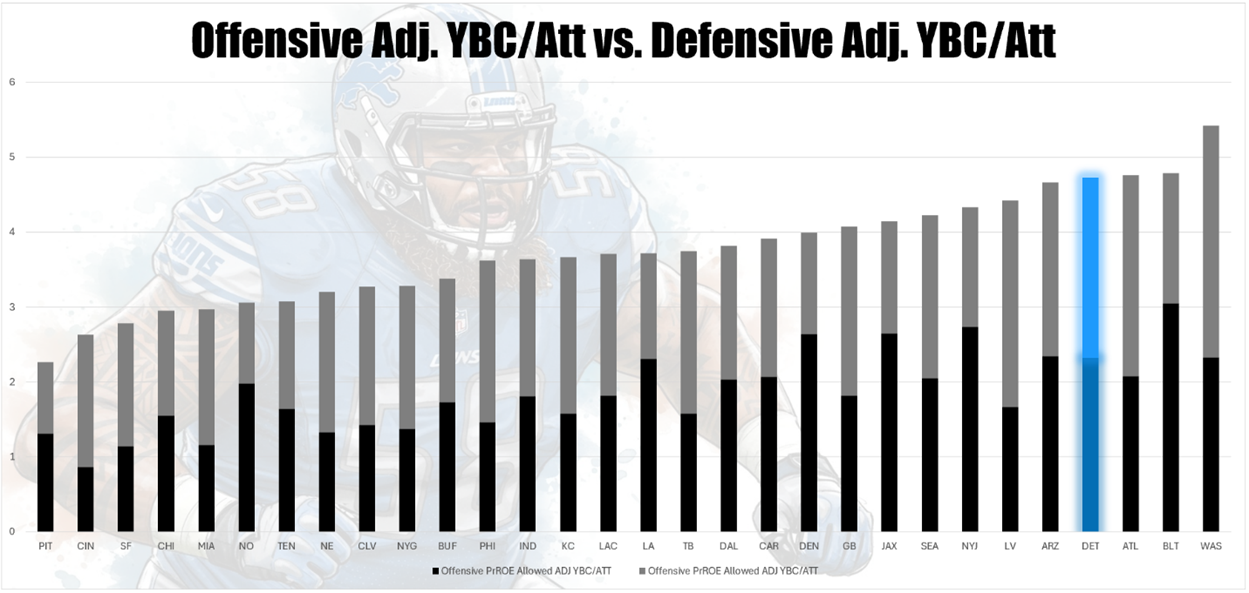
Goff has been affected more by pressure than most this season. His QB rating under pressure is just 67.8 (22nd). His pressure-to-sack rate is 14.9 (18th).
The Chiefs are more vulnerable against the run. Clearly, on paper, this sets up for disaster, as the Lions should be able to impose their will on the ground. This seems like a potentially smart move. It’s an old school way of thinking, but it still applies; if your opponent can’t stop the rush, nothing else is really necessary. And running is more risk-averse than passing, as interceptions are rarer than fumbles and fewer zero-yard gains prevent drives from stalling as frequently. A lot of times, when an OC notices he can earn 4-5 yard chunks consistently, he’ll exploit it for easy first downs.
Not only does it seem practical, it feels like the sort of thing Campbell would relish—smacking a team in the face mano-e-mano and making them succumb to his team’s will over 60 minutes. It’s galvanizing.
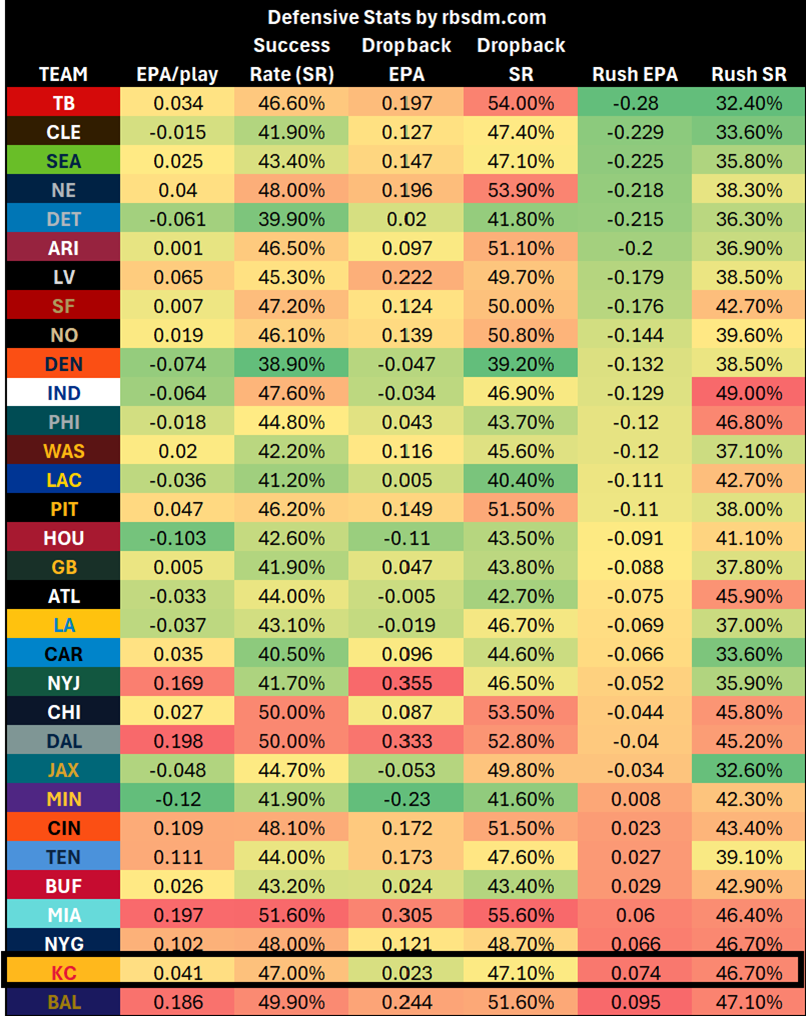
Generally, coaching staffs are not given enough credit for recognizing and planning to mitigate the same types of mismatches we notice when crunching the spreadsheets. Chiefs DC Steve Spagnuolo, a four-time Super Bowl champion with two different teams, is undoubtedly aware of this incongruity. I wouldn't rule out the possibility that he might prioritize stopping the run in his game plan. Still, it’s worth wondering if there is simply anything he can do about it.
The Lions have a concentrated rush attack, with RB Jahmyr Gibbs as the lead back and RB David Montgomery as his complement.

Gibbs is more consistent, likely due to his significant role in the passing game. His 17% target share is fourth among RBs. His 22 receptions are third. 47.8% of his targets come behind the line of scrimmage; he is a dump-off option, not a screen target. He has struggled in yards after catch (YAC) this season, only gaining 124 (12th), with an average of 5.6 YAC/rec (38th). This is likely a matter of not hitting the high end of variance, as last season he ranked 2nd in YAC (650) and 4th in YAC/rec (11.2), so look for a bounce-back.
Montgomery draws fewer opportunities than Gibbs altogether, and he has no significant passing-game role. His TD-dependence makes him more volatile, similar to Goff, but the offensive environment often fosters high TD totals, the same as Goff’s. So far, Montgomery ranks third in rushing TDs, while outpacing Gibbs 8-3 on runs from inside the 5-yard line. Thus far, Montgomery has also been drastically more efficient, with 120 rushing yards over expected (RYOE, 2nd), compared to Gibbs’ five (26th).
It is worth noting that, while KC has ranked better in terms of PPG allowed (96.7 rushing FP, 22nd), they have been strangely unchallenged. The Chargers, Ravens, and Jaguars barely ran at all, and only Philadelphia committed to it. But their opponents did well with the opportunities they took, ranking 6th in YPC, and their opponents have incorporated the RBs well in their passing game when so inclined.

